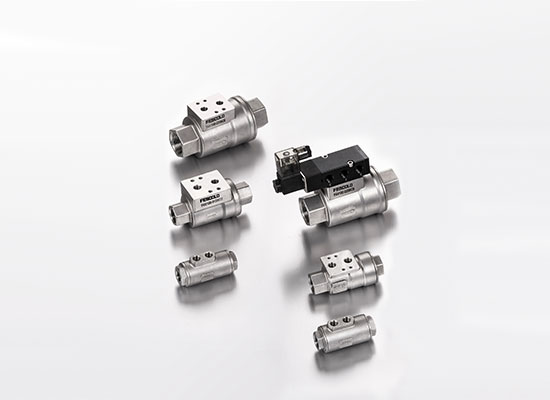What is pneumatic axial valve?
A pneumatic axial valve is a control or shut-off valve driven by a pneumatic actuator, also known as pneumatic control valve or axial flow control valve. Its valve plug moves in the direction of fluid flow (axially).Fluid enters from one end of the valve and exits in a straight line; the valve plug moves in the same direction, helping to reduce flow resistance and impact. It is used to regulate or shut off fluid flow and provides precise control of pressure and flow rate. This type of pneumatic valve is well-suited for high-speed fluids, natural gas pipelines, and large-scale industrial process control, especially effective in high differential pressure and large flow rate conditions.
Advantage of pneumatic axial valve
A pneumatic axial valve is a control valve in which the valve plug moves in the direction of fluid flow (axially) to regulate or shut off the medium.Compare common axial valve,It has Advantages as follow:
◆ Fast Response and High-Frequency Operation
◆ High Safety in Hazardous Environments
◆ Simple Structure and Easy Maintenance
◆ Spring-Return Function for Fail-Safe Operation
◆ High Precision Control
◆ Low Energy Cost and Wide Availability
Structural Composition of Pneumatic Axial Valve
A pneumatic axial valve is a control valve in which the valve core moves in the direction of fluid flow (axially) to regulate or shut off the medium.The pneumatic actuator drives the valve core through compressed air, rather than relying on manual, electric, and hydraulic methods, to achieve rapid response and remote control.
Structural Components
Valve Body:Typically made of aluminum alloy, stainless steel, or engineering plastics for corrosion resistance and lightweight properties.Serves as the outer shell, housing internal components and providing fluid passageways.
Valve Piston:Usually made of stainless steel, nickel plated brass, or wear-resistant polymers, it controls the path of fluids. In the design, there are annular grooves or channels aligned with the valve body to form different flow paths.
Pneumatic Actuator:Generally, pneumatic air cylinders with fast response, long lifespan, ease of automation, and high safety are used as their pneumatic actuators.The mechanism of action is that under the drive of air pressure, the piston rod of the cylinder directly drives the valve core of the pneumatic axial valve.
Sealing Elements:At the positions where the valve stem, valve body, and end cap come into contact with each other,commonly made of PTFE to ensure good sealing performance.
Working Principle
The pneumatic actuator uses compressed air to generate force that moves the valve core and attached valve plug axially (in line with the flow direction). The valve plug adjusts the opening inside the valve body, either restricting or allowing fluid passage, thus controlling flow rate or shutting off flow. The valve seat provides a sealing surface to ensure tight shut-off when the valve is closed. Additionally, a positioner may be installed on the actuator to receive control signals and precisely regulate the valve plug’s position for accurate flow control.
Features of Pneumatic Axial Flow Valve
Pneumatic axial flow valve is designed for high-performance gas flow control in automation systems,driven by pneumatic actuators. Their unique axial flow, fast response, and remote automatic control capabilities give them significant advantages over traditional rotary or linear valves.
Axial Flow Design:Straight-through flow path minimizes pressure drop and turbulence.
Fast Response & High Cycling:Short stroke distance (axial movement) allows millisecond-level switching.
Compact & Lightweight:Linear actuator integration reduces overall size vs. rotary valves.
Robust Sealing:Leak-proof designs critical for vacuum/pressure systems
The Function Of Pneumatic Axial Valve
A pneumatic axial valve is a pneumatic control valve in which the valve plug moves in the direction of fluid flow (axially) to regulate or shut off the medium.
Flow regulation: Precisely modulates the flow rate of gases or liquids by adjusting the axial position of the valve plug.
Pressure control: Helps maintain stable system pressure by throttling flow based on upstream or downstream conditions.
On/off control: Can act as a quick-acting shut-off valve for emergency isolation or process switching.
Smooth flow characteristics: Due to its axial design, it provides minimal pressure loss and flow turbulence, making it ideal for high-pressure, high-speed, or large-flow systems.
Automation-ready: Often equipped with a positioner for integration into automated process control systems (e.g., DCS or PLC).
Applications of Pneumatic Axial Valve
A pneumatic axial valve is a pneumatic control valve in which the valve plug moves in the direction of fluid flow (axially) to regulate or shut off the medium.Penmatic axial flow valve is commonly used in systems where high flow capacity and precise control are crucial.Due to its compact and inline design, it can also be used in places with limited space Some of the key applications include as follows:
◆ Power Generation: In power plants,regulating the flow of steam, gas, or water, ensuring optimal system performance.
◆ Oil and Gas: Used in pipelines and drilling systems, axial flow valves manage the flow of oil and gas with minimal pressure loss, contributing to energy efficiency.
◆ Water Treatment: In water distribution and treatment plants, axial valve helps manage the flow of water with precise control, supporting both system reliability and operational efficiency.
◆ Chemical Processing: Axial valve is used to regulate the flow of chemicals in industrial processes, Its axial flow design ensures accurate control without compromising safety or efficiency.
What is the Difference Between Axial Flow Valve and Globe Valve?
While both axial flow valves and globe valves are used for flow control,all can be operated by pneumatic actuators.they differ significantly in aspects below:
◆ Flow Path: The axial flow valve uses a streamlined design that minimizes pressure drop and turbulence, making it ideal for systems with high flow requirements.In contrast, globe valves typically have a more tortuous flow path, which can cause greater pressure drops.
◆ Pressure Drop: Axial flow valves are designed to minimize pressure losses, while globe valves are more suited for fine flow control, which may result in higher pressure drops.
◆ Size and Design: Axial flow valves are often more compact and designed for larger flow capacities, whereas globe valves are typically more suited for precise flow adjustments in systems with smaller flow rates.
In summary, an axial flow valve has a valve plug that moves along the direction of fluid flow (axially), allowing the fluid to pass through with minimal resistance. On the other hand, a globe valve has a perpendicular flow path where the fluid changes direction inside the valve body, resulting in higher flow resistance but very precise throttling control. Both types can be operated by pneumatic actuators and can be equipped with positioners to achieve automated control.As a manufacturer, fokcavalve mainly provides Pneumatic threaded stainless steel Pneumatic Axial Valve ,Using stainless steel material, Compact design with high durability.
Fokca Pneumatic axial valve
Fokcavalve, among numerous manufacturers of pneumatic axial flow valves, is committed to the production and supply of high-quality Pneumatic control valve and technology solutions.Whether you need assistance with product selection, customization, or after-sales service, our team is always ready to ensure that your pneumatic axial valve meets the specific needs of your pneumatic system. We have different Kinds Of Pneumatic valve products and They are mainly aimed at the American and Italian markets. If you have any questions or need customized pneumatic solutions, please contact us immediately to learn more about our high-quality axial flow valve products.















